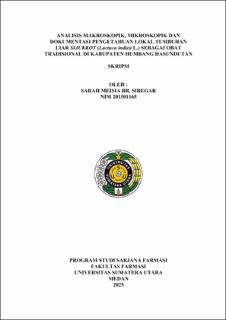Analisis Makroskopik, Mikroskopik dan Dokumentasi Pengetahuan Lokal Tumbuhan Liar Sijukkot (Lactuca indica L.) sebagai Obat Tradisional di Kabupaten Humbang Hasundutan
Analysis of Macroscopic, Microscopic and Documentation of Local Knowledge of Wild Plant Sijukkot (Lactuca indica L.) as Traditional Medicine in Humbang Hasundutan Regency

Date
2025Author
Siregar, Sarah Meisia Br
Advisor(s)
Surbakti, Chemayanti
Sujarwo, Wawan
Metadata
Show full item recordAbstract
Background: Sijukkot is a wild plant traditionally used as medicine in Humbang
Hasundutan Regency. The use of this plant has been passed down through
generations but remains relatively unknown outside the region.
Objective: This study aims to introduce sijukkot as a medicinal plant through
scientific exploration and identification.
Methods: The methods used in this study include macroscopic and microscopic
analysis of the plant simplicia, as well as semi-structured interviews with Batak
informants who possess traditional knowledge. Sample collection was conducted
using a purposive sampling method.
Results: The results showed that microscopic analysis of the leaves identified five
diagnostic fragments: vascular bundles, trichomes, stomata, lower epidermis, and
palisade parenchyma. In the roots, five fragments were found, including ladder
type vascular tissue and sclerenchyma fibers, while the stem contained six
fragments, such as epidermis and xylem vessels. Interview results revealed that
sijukkot is commonly used to treat coughs (22%), flu (22%), stomach pain (16%),
gastric problems (19%), diabetes (12%), and hypertension (9%). The community
generally consumes sijukkot leaves raw as a vegetable salad or boils them with
palm sugar before drinking the infused water.
Conclusion: This study concludes that sijukkot has distinct macroscopic
characteristics, with 16 specific shapes in the leaves, 6 in the stems, and 4 in the
roots. Microscopic analysis identified 5 diagnostic fragments in the leaves, 6 in
the stems, and 5 in the roots. The findings confirm that sijukkot has long been
trusted by the local community for its traditional medicinal benefits.
Keywords: Sijukkot, Lactuca indica, Traditional Medicine, Macroscopic,
Microscopic
Collections
- Undergraduate Theses [1833]
